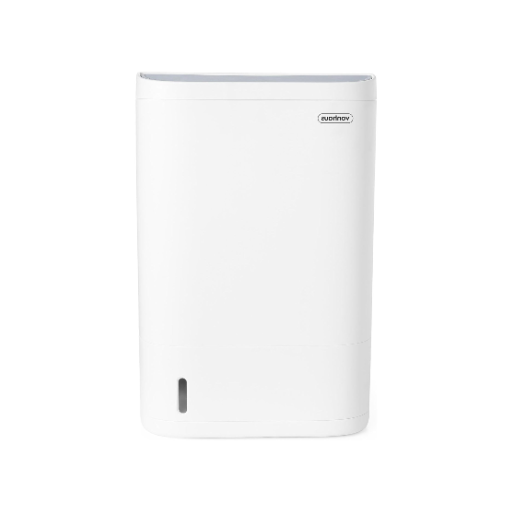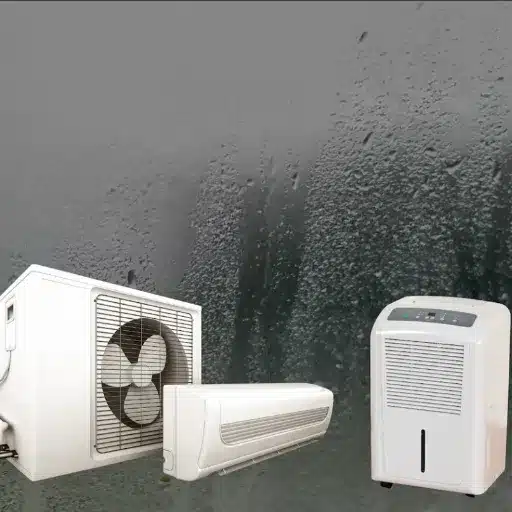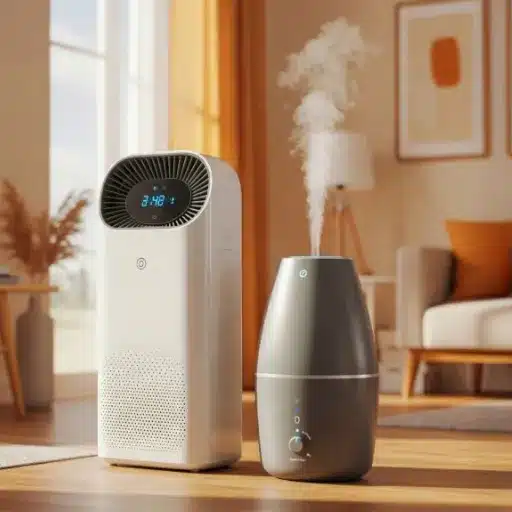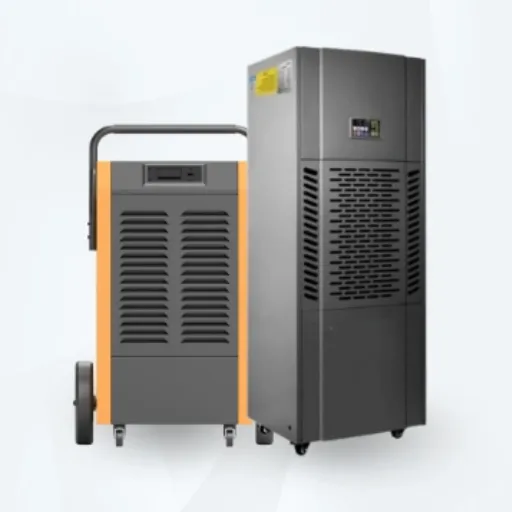A dehumidifier is an essential tool for maintaining optimal indoor air quality and preventing issues like mold and mildew caused by excess moisture. However, it can be frustrating when your dehumidifier stops performing as expected and fails to collect water. This issue not only undermines its effectiveness but can also signal underlying problems that might require attention. In this article, we’ll explore the most common reasons why a dehumidifier might not be collecting water, from environmental factors to potential mechanical faults. Along the way, we’ll provide practical troubleshooting solutions and essential maintenance tips to ensure your dehumidifier operates efficiently. Whether you’re dealing with a minor setback or suspecting a more significant problem, this guide is designed to equip you with the knowledge needed to address the issue confidently.
Understanding Your Dehumidifier
How a Dehumidifier Operates
The dehumidifier removes excess moisture from the air in order to maintain an optimum indoor humidity level. The moist air is sucked in by an intake vent, where it passes over the chilled coils, and condensation occurs. Water droplets are collected in a reservoir or drained through an attached hose while the dry air is let back into the room. This assists with the lowering of the humidity levels, thus limiting mold issues, dust mite problems, and other moisture-related issues.
Most of the dehumidifiers use refrigeration to reduce moisture. This makes the cooling coil, or evaporator as it is sometimes called, a very important piece of equipment for the condensation of moisture into water from warm and humid air. After the air passes over the cooling coils and is rid of its moisture, it gets re-heated by the condenser coils to avoid lowering the temperature in the room before the air is discharged again into the room. Therefore, the system works by continuously taking moisture out without really affecting the ambient temperature.
For the dehumidifier to work efficiently, it should be installed in a well-ventilated area and used under normal environmental conditions. Most models work efficiently in the temperature range of 41°F and 90°F and require maintenance activities, such as cleaning of filters and emptying of water tanks. Also, ensuring that air intakes and exhaust vents are not blocked will promote airflow and performance. Knowing these principles governing dehumidifier operation will aid in troubleshooting and maintenance of the equipment.
Importance of Proper Humidity Levels
Maintaining an appropriate level of humidity is necessary both for health and the structural integrity of buildings. Anything less than this range would otherwise cause the air to become too dry, irritating the respiratory tract, drying out one’s skin, and, with greater drying, adding susceptibility to illnesses. Greater levels of humidity, on the other hand, perform better for mold, dust mites, and bacteria, all of whom would degrade indoor air quality and aggravate allergies or asthma. Excessive humidity can also damage building materials and household items.
On the contrary, moisture may affect wood, drywall, and paint by making them warp, swell, or peel. While low humidity can cause cracking and shrinkage of wood furniture and flooring over time, constant humidity values prevent these issues, hence extending the life of structural elements and fine furniture.
Consider humidifiers or dehumidifiers that will bring their help in maintaining ideal humidity values according to the season and geographical location. Keeping an eye on the humidity levels within the house with a hygrometer is a simple approach to securing the optimal level. These ensure good health, comfort, and longevity for both your house and all of its contents.
Common Reasons for Poor Water Collection
Poor water collection can occur for a broad variety of reasons, ranging from system design issues, maintenance demands, and the influence of outside environmental conditions. All these can greatly hamper the efficiency and effectiveness of a water collection system, whether it be for rain harvesting or irrigation applications, or others.
- System Design Issues: One of the more commonplace reasons for poor water collection is a solution that was not well thought out. It may be the different storage capacities, gutters that may not fit, or the tanks placed in an awkward spot that can greatly diminish the volume of water that can be accrued. These systems could become clogged and be inefficient due to a lack of filtration or overflow provisions.
- Maintenance Issues: Maintenance must be done regularly to prevent whatever could hamper its performance. Debris, such as leaves, soil, and algae, can clog up gutters, pipes, and collection tanks, blocking the flow of water and lowering the rate of collection. Moreover, if pipes or tanks were broken or leaking, they would lessen the efficacy of the water collection system and lead to loss of water.
- Environmental and External Factors: These conditions are equally important. Less rainfall and undetermined precipitation patterns can immediately impede water harvesting. Environmentally aware actions, for instance, the dropping of birds or any sort of contaminants from neighboring establishments, can pollute the water, making it unsafe, unless processed. So, if you think of it, keeping an eye on weather trends and guaranteeing the systems are tailored to the local conditions might be an answer to these complications.
When the three key issues are considered and remedied—that is, design, maintenance, and environment—then water collection efficiency deserves to be dramatically enhanced, thus safeguarding its steady operation.
Identifying the Problem: Why Your Dehumidifier is Not Collecting Water
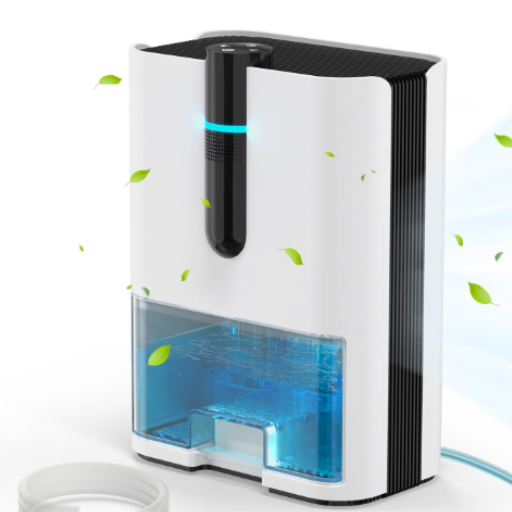
Clogged or Dirty Filters
One of the most common reasons for a dehumidifier not collecting water effectively is clogged or dirty filters. The air filter’s main job in a dehumidifier is to keep dust, dirt, and airborne particles from entering the coils and internal components of the system, thereby affecting their performance. Such filters become dirty over time, thus compromising airflow and the ability of the machine to condense moisture from the air.
When airflow is impeded owing to restricted air through a clogged filter, the evaporator coil cannot work at its full efficiency. This will eventually reduce the amount of water being extracted by the dehumidifier and hence affect the system operation as a whole. Thus, it is important that they are either washed or replaced regularly according to the manufacturer’s instructions or whenever a drop in performance is detected.
Cleaning filters on most models would require the filter to be taken out from the unit and gently washed with warm, soapy water before allowing it to air dry completely. When the filter is torn or heavily clogged, it is recommended to replace the existing filter with a new one of the appropriate type for that model. Keeping the filters maintained will improve water collection and may increase the life of the dehumidifier by reducing strain on its internal components.
Incorrect Humidity Settings
Inappropriate humidity settings in a dehumidifier can cause improper operational efficiency and long-lasting effects on indoor air quality. Generally, dehumidifiers are most efficient when the desired RH (relative humidity) level is set according to the particular space and its intended use. For instance, the generally accepted level of indoor RH is anywhere between 30-50%, as lower values may cause dryness and discomfort, while higher levels cause moist discomfort, with mold and higher dust mite creations being produced as byproducts of such excessive moisture. If the dehumidifier is set on a range either below or higher than recommended, these will either overwork, thus increasing energy consumption, or will be inadequate to keep the moisture levels under control.
When such improperly calibrated settings are coupled with other aggravating factors such as seasonal shifts and certain conditions of the room, they tend to make matters worse. Most of the time, moisture concentrations will hit an operative peak during humid summer days and require the RH levels to be balanced meticulously to achieve the setpoint needed by a dehumidifier. On the other side of the coin, during winter, indoor humidity tends to fall naturally due to heating systems. If excessive dehumidification were allowed to occur, the dryness of the atmosphere would go on to the detriment of the wooden works and the respiration of human beings. Updating the settings in extra alignment with the environment every once in a while is thus just good practice to look after.
Modern devices can also come with a built-in hygrometer or humidity sensor to help accommodate the adjustments. Should there be a malfunction or miscalibration reported with these sensors, this could potentially cause undesirable results and interfere with overall operation. Maintenance from time to time, including cleaning of sensor parts and verifying its accuracy with the use of other external tools, helps to avert such problems. Comprehending and taking control of humidity settings proper for both the outside environment and the specific needs of the space leads to reliable moisture stay with the comfort of the users and cuts down energy expenditure.
Malfunctioning Components
When it comes to malfunctioning parts, one has to carry out a systematic identification of the faulty part and understand its working role within the system. This includes components such as sensors, control units, or motorized parts, which may wear out over time, become contaminated, or have electrical faults. For instance, if a humidity sensor is miscalibrated, incorrect readings will be transmitted, thereby affecting adjustments and efficiency in system performance. Thus, it becomes important to apply normal diagnostic procedures to see if each part is operating within its specified tolerances and is communicating correctly with the rest of the system.
From my experience, I would say the first step in taking care of malfunctioning parts is to identify the symptoms through which it is manifesting. Erratic system behavior or inconsistent output usually signals a failure somewhere in the chain of operation. I always try to refer to the technical documentation of the equipment to clarify standard values and performance limits. With such a methodical approach, when it comes to repair or replacement, the action is definite, thus reducing downtime.
Moreover, preventive maintenance is a safeguard against component failure. I consider periodic inspections, cleaning, and calibration as indispensable in catching a developing fault before it escalates into a big issue, thereby prolonging the life of critical parts and maximizing system performance. An environment in which something is of record will keep malfunctions at bay, making for a steady reliability.
Troubleshooting Steps for Your Dehumidifier
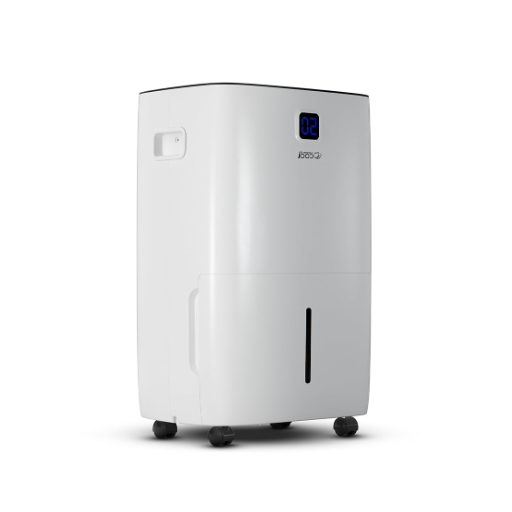
Checking the Filters and Cleaning Them
The filters in your dehumidifier serve an indispensable purpose to ensure that the unit operates smoothly by blocking dust, debris, and other airborne particles. Dirt may accumulate on these filters over time, hindering proper airflow and decreasing the operational efficiency of the unit. Always check the filters by ensuring that the unit is unplugged from any electrical socket for safety reasons. Then, remove the filter cover, usually found near the air intake panel, and take out the filter carefully.
Check the filter to look for any dirt or blockage; if dirt is visible, vacuum the filter or rinse it under lukewarm water, unless specified otherwise by the manufacturer. Make sure to allow the filter to dry completely before reinserting it; wet filters can damage the internal components of the unit. For best performance, clean and check the filters according to intervals specified in the user manual, which is often correlated to how often the dehumidifier is in use and environmental factors such as the amount of dust.
Keeping the filters clean also optimizes performance and energy consumption, while allowing the dehumidifier to have a much longer life. By paying regular attention to this small but vital part, you ensure steady and reliable drying, which will protect your indoor environment from issues caused by excess moisture, such as mold and mildew growth.
Verifying Humidity Settings
The dehumidifier installation checklist for moisture control has more than one important step related to humidity setting verification. Modern dehumidifiers usually have a built-in hygrometer to measure the relative humidity (RH) of the environment. The choice of indoor humidity level is between 30% and 50%, depending primarily on the weather outside and the season. It is imperative to periodically check and adjust the settings to ensure they maintain the desired RH level in the area, thus preventing any condensation or dry-air conditions.
While considering the setting of the required humidity, keep in mind the specific needs of the area requiring treatment. For example, basements are prone to increased humidity due to lesser degrees of ventilation and typically cool temperatures, and thus may require an RH setting lower than that which would be applicable to a living area. Rooms holding wooden furniture, musical instruments, or sensitive electronics may require tight control to avoid damage caused by fluctuating humidity. Using the data local to the hygrometer, combined with knowledge about the room’s needs, allows a user to make an informed setting.
Further assistance in monitoring and verifying humidity levels might be provided by external sensors or smart-home-type systems offering real-time data and alerts. Such systems minimize the margin for human error and ensure that an area does not become conducive to mold, mildew growth, or even structural damage. Dehumidifiers equipped with auto adjustments for humidity level ensure seamless operations. Together, using these sophisticated systems complemented with regular maintenance and filter cleaning would greatly improve the precision of micro-environment control-going-so-much-farther to the extended life of the apparatus. At the end of the day, accurate verification of humidity is an inexorable parameter for any workable moisture management plan.
Inspecting the Fan Motor and Electronic Control Board
The fan motor and electronic control board together constitute the core elements considered in determining their efficient working of various state-of-the-art environmental control systems. The fan motor inspection should be carried out by evaluating its running efficiency, checking for any physical wear, and listening for any abnormal noise or vibration during its operation. Such abnormalities could potentially depict incidents like component misalignment, inadequate lubrication, or even electrical faults. The speed rotation of the fan motor may also be checked as per the design configuration; any deviations from the allowed air velocity in the design may cause inadequate airflow, leading to system performance.
Moving simultaneously, the electronic control board should be systematically examined for faults or failures in components such as capacitors, resistors, or semiconductor switches serving as the signal processing stages during the control actions for keeping the desired level of performance. Check for any visual damage signs like corrosion, burn marks, or swelling of any electronic component, as these usually serve to identify situations such as overcurrent or thermal stress. Then, verify that the board is able to send appropriate signals to the connected components, since improper signaling generally leads to increased operational inefficiencies or malfunctions. Diagnostic equipment such as multimeters, oscilloscopes may also be used for measuring circuit continuity, voltage outputs, waveform integrity, and ensuring the board functions within its set threshold.
While testing both parts together, an integrated method should test how these two components relate to the system at an architectural level. Each situation in which any fault ops in the control board or the miscommunication between the fan motor and the control board would translate into the fan operating erratically in terms of speed or would compromise the entire system by causing inappropriate shutdown sequences should be considered as a primary source of system unfaithfulness. Both hardware and firmware diagnostics should be undertaken to establish the extent of their performance optimizations and to detect the presence of either software bugs or obsolescence in the implemented software. Periodic inspections using the latest advances in diagnostic technology will address potential failures, extending the very life of the equipment and retaining accurate environmental control.
Solutions to Common Issues

Replacing Filters and Maintenance Tips
The regular replacement of filters is an important aspect of maintaining optimal HVAC system performance. Filters trap airborne particles such as dust, pollen, and microbes to help circulate clean air in the system. Over time, filters trap dirt so much that airflow gets restricted, and the system will have to work harder, consuming more energy or even leading to breakdowns.
Hence, it is best to check the filters once every month and replace them when they appear dirty to the naked eye or based on manufacturer’s recommendations, which is usually from 1 to 3 months for residential systems. Filters that are of the high-efficiency category like HEPA or MERV-rated may have to be checked more often since these filters have a dense matrix that collects particulates with greater efficiency.
Maintaining the system should also include cleaning the evaporator and condenser coils, as dirt accumulation lessens their heat exchange capabilities. Lubrication of all moving parts regularly, such as fans and motors, checking the electrical connections for looseness, etc., helps to keep the system in top form. Clearance of all debris around the outdoor unit, such as leaves or grass clippings, will go a long way in ensuring excellent airflow and preventing the unit from overheating. When all these activities are properly carried out with system operation by industry standards like ASHRAE guidelines, the resultant performance would truly be outstanding.
Adjusting Settings for Optimal Performance
To ensure an optimum performance of the system, it is essential to fine-tune its operational settings. Fine-tuning involves adjusting such as temperature setpoint, fan speed, and operational mode according to the prevailing environmental conditions and user requirements. Going back to HVAC systems, setting the temperature within the ASHRAE-recommended range ensures a comfortable atmosphere for humans while conserving energy. Similarly, fan speed should be regulated to achieve an efficient airflow while consuming low energy.
Greater perfection is attained when the latest techniques in machine learning and smart technologies are applied during optimization. Setting on-time data on indoor and outdoor conditions helps modern systems to fine-tune themselves. Putting in the data from IoT-enabled sensors could allow further refinement in control by gathering data on humidity levels, occupancy patterns, and peak operation hours. These are the instruments that serve to reduce energy wastage and allow the system to accommodate some degree of change rather than sticking to static and manual adjustments that very often may lead to inefficiencies.
An application of technical precision merged with smart automation will greatly benefit the system in terms of complying with the latest standards and guidelines. The detailed approach will ensure that the system has a longer life and, through that, savings will be accrued and the environment strengthened toward sustainability.
Repair Options for Malfunctioning Parts
Resolution of faulty components, whether partial or complete, demands a surgical diagnosis followed by appropriate treatment. The first step involves performing some kind of diagnostic procedure to perhaps get to the root cause of the problem. A thermal camera, ultrasonic tester, or advanced diagnostic software are all efficient weapons in the arsenal and can be opted for according to the type of equipment involved. After diagnosing it, the following repair options might be considered:
- Replacing the Component: Where damage is confined to some particular item, replacing this item with an OEM one, or at least one equivalent in certification, would not disrupt any functional or performance requirements.
- Repairs with Upgraded Materials: In cases of repeated failure, it may be worth the cost of an upgrade to better materials that are stronger or corrosion-resistant from the point of failure, to increase system life and lessen future breakages.
- Reconditioning or Refurbishing: This particularly applies to certain components, wherein reconditioning can bring them back to working order. This is a practical option for expensive components, and may involve machining, cleaning, or recoating.
- Software Updates or Calibration: Many modern systems rely at least in part on integrated software or calibration settings. Firmware updates, recalibration of sensors, or resetting to factory defaults may be the answer to fixes for operational inaccuracy.
- Proactive Maintenance: It is advisable, while repairing an obvious failure, to investigate related parts for possible weaknesses that might come to failure shortly.
Advanced data monitoring platforms can be employed in keeping track of system conditions on a timely basis for more focused repair and in maximizing system uptime. By pairing these technical approaches with a detailed historical equipment performance log, operators can work towards improving overall system resilience and efficiency.
Preventative Maintenance for Your Dehumidifier
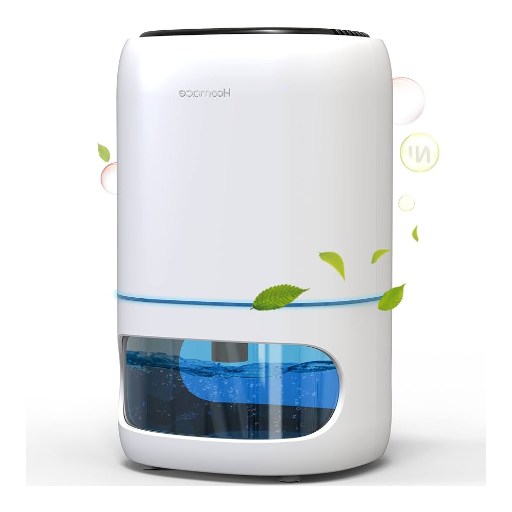
Regular Cleaning and Filter Replacement
Regular cleaning and timely filter change are considered very basic preventive maintenance activities for any dehumidifier. Filters get clogged with dust, debris, and other particulates, which can obstruct the airflow and hence diminish the apparatus’s efficiency. Filter checks for best performance should be done every month at a minimum, with replacement mandatory at every three months or even sooner in an environment laden with particulate matter.
Cleaning of coils and the fan of the dehumidifier is just as essential, as dirt can reduce the efficiency of heat exchange and lead to system failure. Gently brush or vacuum away dirt on the coils, and be careful not to damage the fins. If kept clean, the unit will carry less load and dehumidify smoothly and consistently.
Studies and advancements in material technology have highlighted the ever-increasing array of high-performance filters capable of capturing finer particles without compromising airflow. HEPA-type filters are highly recommended in situations where much importance is given to air quality. Together with regular maintenance, the use of an ideal filter technology equates to ultimate energy saving and air quality, which would result in long-term benefits for the user.
Monitoring Room Conditions
Maintaining a good workable environment indoors finds applications from acts ensuring occupant comfort to the operation of heavy equipment, etc. Parameters like temperature, humidity, and particulate matter should be served with precision to create controlled environments. Advanced sensor technologies with combinations of IoT-based platforms worldwide provide a real-time collection and analysis framework. Such systems can put users into a position to describe trends, spot anomalies, and immediately fix any deviation from the set condition. An example is the employment of temperature sensors capable of ±0.1°C accuracy in server rooms, where the slightest change would affect the performance and longevity of the equipment.
If well taken care of, monitoring through these systems will allow air quality to be controlled while conserving energy. Patterns of application can be identified and used to suggest amendments to HVAC operation by algorithm-driven insights from IoT platforms, thereby maintaining constant performance. As an illustration, trend analysis in humidity data can be used in automated control systems to operate dehumidifiers or humidifiers to maintain humidity levels within health and structural integrity limits. Real-time particulate sensors are capable of detecting PM2.5 and PM10 level thresholds and setting air filtration systems into action once the specified levels are surpassed, which directly supports WELL-being enhancement.
Besides, the integration of these systems onto a cloud-based platform offers complete visualization as well as remote management. Dashboards, in comparison to other sources of room condition data over time, represent a strong solution when it comes to pinpointing troubleshooting and informed decision-making. These solutions find particular applications in interoperability in labs, hospitals, or manufacturing plants, wherein any deviation could lead to disastrous consequences. Innovations in room condition monitoring mark their relevance in carving healthier, safer, and energy-efficient indoor spaces under stringent environmental and operational criteria.
References
-
University of Minnesota Extension: Controlling moisture problems in your home – This source provides insights into managing moisture issues, including the use of dehumidifiers.
-
University of Rochester Medical Center: Air Filters, Dehumidifiers, and Humidifiers – Discusses the role of dehumidifiers in maintaining indoor air quality and potential issues.
-
HUD User (U.S. Department of Housing and Urban Development): Moisture Problems in Manufactured Homes – Offers detailed information on moisture control and the use of dehumidifiers in specific environments.
Frequently Asked Questions (FAQ)
Q: Why is my dehumidifier not collecting water even when the humidity is high?
A: If your dehumidifier is not collecting water despite high humidity levels, it could be due to several reasons. One common issue is that the ambient humidity might not be high enough for the appliance to function properly. Dehumidifiers are designed to work best in environments with relative humidity levels above 50%. Ensure that the room temperature is within the optimal range to allow the compressor and refrigerant to operate efficiently.
Q: What should I do if the collection bucket is full but the dehumidifier is still not collecting water?
A: If the collection bucket is full, the dehumidifier may stop working until the bucket is emptied. Check if the bucket is properly seated in the appliance. If it is and the unit is still not collecting moisture, there may be issues with the air filter or coils in your dehumidifier being blocked by dust and debris. Regular cleaning can prevent these issues.
Q: Could frozen coils be the reason my dehumidifier is not working?
A: Yes, frozen coils can significantly impact the dehumidifier’s ability to extract moisture. This usually happens when the air temperature is too low or when airflow is restricted due to a dirty air filter. If you notice frost on the coils, allow the unit to thaw before troubleshooting further.
Q: How does room temperature affect my dehumidifier’s performance?
A: Room temperature plays a crucial role in how effectively your dehumidifier operates. Most units function best at temperatures between 70 and 90 degrees Fahrenheit. If the temperature drops below this range, the appliance may struggle to collect water or may freeze up, leading to reduced efficiency.
Q: What are some potential issues if my dehumidifier is running but not collecting water?
A: Several potential issues could cause this problem. First, check if the air filter is clean and not blocked. A dirty filter can restrict airflow, impacting moisture extraction. Additionally, if the compressor is malfunctioning or if there are issues with the refrigerant levels, the dehumidifier may not operate effectively.
Q: How can I tell if the dehumidifier is functioning properly?
A: To determine if your dehumidifier is functioning properly, monitor the collection bucket for water accumulation. If water is being collected, check the ambient humidity levels and ensure they are within the optimal range. Regular maintenance, such as cleaning the air filter and inspecting the coils, is also essential for optimal performance.
Q: Is it worth it to repair a dehumidifier that has a low lifespan?
A: Whether to repair a dehumidifier with a low lifespan depends on the cost of repair parts and the unit’s overall condition. If the appliance is still under warranty and the repair is covered, it may be worthwhile. However, if repairs are costly and the unit is older, investing in a new, more cost-effective model might be the better choice.
Q: Can routine maintenance prevent my dehumidifier from freezing up?
A: Yes, routine maintenance is crucial for preventing your dehumidifier from freezing up. Regularly cleaning the air filter and ensuring that the coils are free of dust and debris can help maintain optimal airflow and efficiency. Keeping the appliance in a suitable temperature range will also minimize the risk of freezing.
Q: What are the signs that my dehumidifier needs to be serviced by a technician?
A: If your dehumidifier is not collecting water and there are no visible blockages, it may be time to call a technician. Other signs include unusual noises, persistent error messages, or if the unit operates but does not effectively reduce humidity levels. A professional can diagnose and address any underlying issues, ensuring your dehumidifier functions efficiently.

